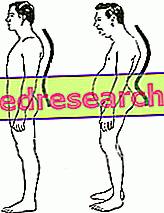By Dr. De Domenico Giuseppe
| The column vertebral | Hypercosis: evaluation e treatment | Gym treatment |
The spine
The vertebral column or rachis is an osteoarthromuscular formation formed by superimposed and articulated bone segments, the vertebrae, and is found dorsally in the trunk.
In it they distinguish four segments or " traits " that correspond to the four parts in which the trunk is divided:
- The cervical tract, formed by seven cervical vertebrae in which the first of them is articulated with the occipital bone, which belongs to the skull, while the last articulates with the first of the thoracic vertebrae.
- The thoracic tract, consisting of twelve thoracic vertebrae with which the ribs are articulated.
- The lumbar tract consists, instead, of five lumbar vertebrae, the last of which is placed in junction with the sacrum.
- The pelvic tract of the spine has a different constitution than that of the parts that precede it; it is, in fact, formed by two bones, the sacrum and the coccyx, which derive from the fusion of numerous primitive vertebral segments that articulate each other; the sacred also articulates with the two bones of the hip. Five constituent segments can be identified in the sacrum, four or five in the coccyx.
The vertebral column is therefore formed by 33 or 34 bone segments.
General characteristics of the vertebrae
With the exception of the sacrum and coccyx, whose vertebral segments are fused together and strongly modified, the vertebrae can be recognized as having general constitution characteristics and also particular conformations that allow them to be assigned to a specific section of the column, and in some cases to recognize them individually.
The vertebrae are short bones formed by a body and an arch, which together define a vertebral hole .
Each vertebra is also made up of:
- a spinous process;
- two transverse processes;
- four articular apophyses, two superior, two inferior, placed laterally;
- two plates;
- two peduncles that connect the body of the vertebra to the apophyses.
The twenty-four upper, mobile vertebrae are connected to each other by:
- Intervertebral discs
- Ligaments in longitudinal direction
- Joints between joint processes
- Muscles
The intervertebral discs, fibrocartilaginei, act as a "buffer" between the vertebrae. At the center of the disc is the nucleus pulposus, gelatinous, devoid of capillaries, surrounded by concentric fibers of fibrous cartilage.
Physiological curves of the spine and their origin
Straight on the frontal plane, the spine has three curves on the sagittal or anteroposterior plane, justified by the requirements of the upright and walking, as well as the shape of the intervertebral discs and of the vertebrae themselves; these curves are:
- cervical physiological lordosis, anterior convexity of the cervical tract
- dorsal physiological kyphosis, posterior convexity of the thoracic tract
- lumbar physiological lordosis, anterior convexity of the lumbar spine
These curves are more or less accentuated depending on whether the sacrum, which forms the base of the column, or the vertebrae immediately above it, are more or less inclined with respect to the horizontal. If the sacred is tilted forward they tend to be accentuated, and vice versa.
The value of the curves is considered in the standard - according to Rocher-Rigaud - when:
- it is about 36 ° for physiological cervical lordosis;
- it is about 35 ° for physiological dorsal kyphosis;
- it is about 50 ° for physiological lumbar lordosis.
Deviations from the physiological position can be caused by a tissue imbalance (muscles, ligaments, tendons), or by structural bone abnormalities.
Clinically the alterations of the normal body morphology are distinguished in:
- Paramorphisms,
- Dysmorphisms .
In the paramorphisms the morphological deviation is the result of incongruous positions maintained by vicious postural habits, pain etc.

Paramorphisms are of favorable functional prognosis as they are easily reversible, especially if they are diagnosed early and treated.
Abandoned to themselves, especially during the age of development, some paramorphisms can sometimes turn into dimorphisms due to the progressive establishment of skeletal structural modifications. The dimorphisms represent, therefore, of the modifications of the normal morphology, sustained by congenital alterations (malformations) or acquired of the osteofibrose structures. The latter cannot be corrected without proper orthopedic treatment.
Among the most common paramorphisms we distinguish:
- Hyperlordosis, accentuation of the lumbar lordotic curve
- Hypercyphosis, accentuation of the dorsal kyphotic curve
- Winged Scapulas
- Scoliotic attitude .
CONTINUE: Dorsal Hypercosis »



